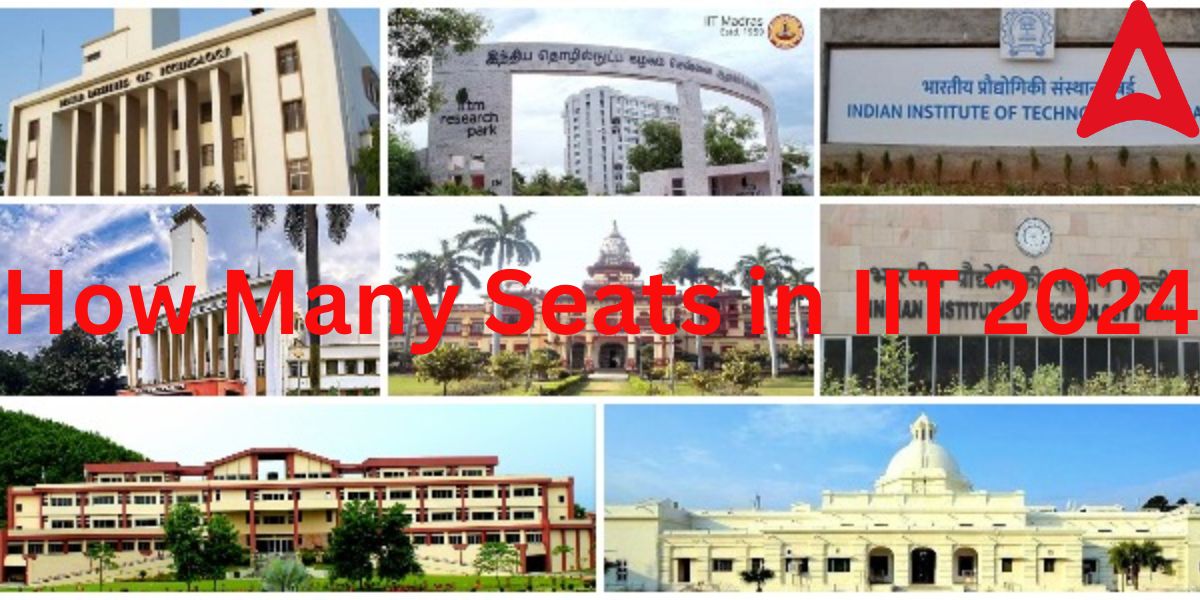IITs are the premier engineering institutions in India but only a few can walk through the coveted doors of these magnificent engineering marvels. Growing up in India, every single Indian aspirant dreams of going to these mighty IITs. IITs offers various courses at undergraduate, postgraduate and doctoral levels. The most famous and competitive courses to get into the IITs are the undergraduate (BTech) and postgraduate (MTech) engineering courses. In this Post we discussed total seats in iit in India, and also we give answer of this question, how many seats are there in iit. Let’s check it out.
Total Seats in IIT
To get a seat at the prestigious IITs in B Tech or MTech, one needs to clear highly competitive exams like JEE Advanced and GATE respectively. There has been an increase in the total number of IIT colleges and seats offered by them. In this article, we will be providing students with the details of the number of seats available at different IITs to give an idea about the level of competition they would face.
Note: Total Undergraduate Seats (2023): Approximately 16,598
How Many Seats are There in IIT 2024
While the exact number of seats can vary annually based on new policies, expansions, and the introduction of new programs, here is a general breakdown:
- IIT Bombay: Approximately 1,200 undergraduate seats
- IIT Delhi: Approximately 1,200 undergraduate seats
- IIT Kanpur: Approximately 1,100 undergraduate seats
- IIT Kharagpur: Approximately 1,600 undergraduate seats
- IIT Madras: Approximately 1,200 undergraduate seats
- IIT Roorkee: Approximately 1,400 undergraduate seats
- Newer IITs (e.g., IIT Bhilai, IIT Goa, IIT Jammu, etc.): Typically range from 200 to 500 undergraduate seats each
How many seats are there in IIT
There are only a few thousands seats in IIT for which lakhs of students compete. The Indian Institutes of Technology (IITs) are India’s top engineering colleges, renowned for their academic prowess and stringent admissions procedures. Throughout the nation, aspirant engineers compete to get into these esteemed institutions each year. The admissions process at IITs is extremely difficult due to the limited amount of seats offered.
The top IITs each offers around 1200 seats for the BTech program. The number of MTech seats at each college varies from 20 to more than 1000. Since, the number of seats fluctuate every year, it is better to know about the latest data in order to have the correct information. So, we are presenting the latest number of seats in different IITs for the year 2024.
Total IIT Seats in India 2024 in BTech
There are 23 IITs in India that are functional. The number of total seats in IIT have been recently increased to 17,385 for the B Tech program. Earlier there was 16,598 seats in IITs for the B Tech programs. The number of seats available in different IITs is given below.
| IIT College Name | Number of Seats |
| IIT Bhubaneswar | 260 |
| IIT Bombay | 903 |
| IIT Mandi | 150 |
| IIT Delhi | 851 |
| IIT Indore | 260 |
| IIT Kharagpur | 1341 |
| IIT Hyderabad | 240 |
| IIT Jodhpur | 120 |
| IIT Kanpur | 827 |
| IIT Madras | 838 |
| IIT Gandhinagar | 180 |
| IIT Patna | 200 |
| IIT Roorkee | 970 |
| IIT (ISM) Dhanbad | 912 |
| IIT Ropar | 155 |
| IIT (BHU) Varanasi | 1090 |
| IIT Guwahati | 615 |
| IIT Bhilai | 120 |
| IIT Goa | 90 |
| IIT Palakkad | 123 |
| IIT Tirupati | 120 |
| IIT Jammu | 90 |
| IIT Dharwad | 120 |
| Total Seats | 17,385 |
How many IIT Seats in India for MTech
As we know, IITs offer higher degree in engineering and research. This program is known as MTech (Master of Technology). Admission into the MTech program at IITs take place through the GATE exam. The number of MTech seats available in different IITs vary each year. So, students must refer to the latest data of MTech seats available for 2023 given below.
| IIT Name | Number of Seats |
| IIT Bombay | 928 |
| IIT Delhi | 1452 (Tentative) |
| IIT Bhubaneswar | 244 |
| IIT (ISM) Dhanbad | 680 |
| IIT Guwahati | 634 |
| IIT Gandhinagar | 280 |
| IIT Indore | 48 |
| IIT Hyderabad | 162 |
| IIT Jodhpur | 30 |
| IIT Kanpur | 831 |
| IIT Mandi | 48 |
| IIT Madras | 431 |
| IIT Patna | 120 |
| IIT Ropar | 20 |
| IIT Roorkee | 818 |
| IIT Varanasi | 337 |
| IIT Kharagpur | 1400 (Approximately) |
| Total Seats | 8463 (Approximately) |
How Many Seats in IIT Delhi
IIT Delhi is one of the premier institution that always feature among the top 5 engineering colleges in India. Almost every engineering aspirant aspire to get admitted into the engineering courses of IIT Delhi. For that, students must chalk out a proper plan and know the number of seats available in different disciplines. For this purpose, we are providing students with the details of the number of seats available in IIT Delhi.
| Discipline | Seat Pool | OPEN | OPEN-PwD | GEN-EWS | GEN-EWS-PwD | SC | SC-PwD | ST | ST-PwD | OBC-NCL | OBC-NCL-PwD | Total (includes Female Supernumerary) | Program-Total | |
| Seat Capacity | Female Supernumerary | |||||||||||||
| Biotechnology and Biochemical Engineering (4 Years, Bachelor of Technology) | Gender-Neutral | 22 | 1 | 5 | 1 | 8 | 1 | 4 | 0 | 15 | 0 | 57 | 72 | 0 |
| Female-only (including Supernumerary) | 6 | 0 | 2 | 0 | 2 | 0 | 1 | 0 | 3 | 1 | 15 | |||
| (including “0” Supernumerary) | ||||||||||||||
| Chemical Engineering (4 Years, Bachelor of Technology) | Gender-Neutral | 23 | 1 | 6 | 0 | 9 | 0 | 5 | 0 | 16 | 0 | 60 | 75 | 0 |
| Female-only (including Supernumerary) | 6 | 0 | 1 | 1 | 2 | 0 | 1 | 0 | 4 | 0 | 15 | |||
| (including “0” Supernumerary) | ||||||||||||||
| Civil Engineering (4 Years, Bachelor of Technology) | Gender-Neutral | 34 | 2 | 8 | 1 | 12 | 1 | 6 | 1 | 22 | 1 | 88 | 108 | 2 |
| Female-only (including Supernumerary) | 8 | 1 | 2 | 0 | 3 | 0 | 2 | 0 | 6 | 0 | 22 | |||
| (including “2” Supernumerary) | ||||||||||||||
| Computer Science and Engineering (4 Years, Bachelor of Technology) | Gender-Neutral | 30 | 2 | 7 | 1 | 11 | 1 | 5 | 1 | 20 | 1 | 79 | 93 | 6 |
| Female-only (including Supernumerary) | 8 | 0 | 2 | 0 | 3 | 0 | 2 | 0 | 4 | 1 | 20 | |||
| (including “6” Supernumerary) | ||||||||||||||
| Electrical Engineering (4 Years, Bachelor of Technology) | Gender-Neutral | 37 | 2 | 10 | 0 | 13 | 1 | 7 | 0 | 25 | 1 | 96 | 110 | 10 |
| Female-only (including Supernumerary) | 9 | 1 | 2 | 0 | 4 | 0 | 2 | 0 | 6 | 0 | 24 | |||
| (including “10” Supernumerary) | ||||||||||||||
| Electrical Engineering (Power and Automation) (4 Years, Bachelor of Technology) | Gender-Neutral | 20 | 1 | 5 | 0 | 7 | 1 | 4 | 0 | 13 | 1 | 52 | 61 | 4 |
| Female-only (including Supernumerary) | 5 | 0 | 1 | 0 | 2 | 0 | 1 | 0 | 3 | 1 | 13 | |||
| (including “4” Supernumerary) | ||||||||||||||
| Engineering Physics (4 Years, Bachelor of Technology) | Gender-Neutral | 19 | 1 | 5 | 0 | 8 | 0 | 3 | 0 | 14 | 0 | 50 | 63 | 0 |
| Female-only (including Supernumerary) | 5 | 0 | 1 | 0 | 2 | 0 | 1 | 0 | 4 | 0 | 13 | |||
| (including “0” Supernumerary) | ||||||||||||||
| Mathematics and Computing (4 Years, Bachelor of Technology) | Gender-Neutral | 28 | 1 | 6 | 1 | 10 | 1 | 4 | 1 | 18 | 1 | 71 | 86 | 3 |
| Female-only (including Supernumerary) | 6 | 1 | 2 | 0 | 3 | 0 | 1 | 0 | 5 | 0 | 18 | |||
| (including “3” Supernumerary) | ||||||||||||||
| Mechanical Engineering (4 Years, Bachelor of Technology) | Gender-Neutral | 30 | 1 | 6 | 1 | 10 | 1 | 6 | 0 | 20 | 1 | 76 | 85 | 10 |
| Female-only (including Supernumerary) | 7 | 1 | 2 | 0 | 3 | 0 | 1 | 0 | 5 | 0 | 19 | |||
| (including “10” Supernumerary) | ||||||||||||||
| Production and Industrial Engineering (4 Years, Bachelor of Technology) | Gender-Neutral | 27 | 1 | 7 | 0 | 10 | 1 | 5 | 1 | 18 | 1 | 71 | 81 | 8 |
| Female-only (including Supernumerary) | 6 | 1 | 2 | 0 | 3 | 0 | 1 | 0 | 5 | 0 | 18 | |||
| (including “8” Supernumerary) | ||||||||||||||
| Textile Technology (4 Years, Bachelor of Technology) | Gender-Neutral | 30 | 1 | 8 | 0 | 10 | 1 | 5 | 1 | 19 | 1 | 76 | 91 | 5 |
| Female-only (including Supernumerary) | 7 | 1 | 2 | 0 | 3 | 0 | 1 | 0 | 6 | 0 | 20 | |||
| (including “5” Supernumerary) | ||||||||||||||
| Engineering and Computational Mechanics (4 Years, Bachelor of Technology) | Gender-Neutral | 12 | 1 | 3 | 0 | 5 | 0 | 2 | 0 | 8 | 1 | 32 | 40 | 0 |
| Female-only (including Supernumerary) | 2 | 1 | 1 | 0 | 1 | 0 | 1 | 0 | 2 | 0 | 8 | |||
| (including “0” Supernumerary) | ||||||||||||||
| Materials Engineering (4 Years, Bachelor of Technology) | Gender-Neutral | 13 | 0 | 3 | 0 | 5 | 0 | 2 | 0 | 8 | 1 | 32 | 40 | 0 |
| Female-only (including Supernumerary) | 2 | 1 | 1 | 0 | 1 | 0 | 1 | 0 | 2 | 0 | 8 | |||
| (including “0” Supernumerary) | ||||||||||||||
| Energy Engineering (4 Years, Bachelor of Technology) | Gender-Neutral | 13 | 0 | 3 | 0 | 5 | 0 | 2 | 0 | 8 | 1 | 32 | 40 | 0 |
| Female-only (including Supernumerary) | 2 | 1 | 1 | 0 | 1 | 0 | 1 | 0 | 2 | 0 | 8 | |||
| (including “0” Supernumerary) | ||||||||||||||
| Chemical Engineering (5 Years, Bachelor and Master of Technology (Dual Degree)) | Gender-Neutral | 13 | 1 | 4 | 0 | 5 | 0 | 3 | 0 | 10 | 0 | 36 | 44 | 2 |
| Female-only (including Supernumerary) | 4 | 0 | 1 | 0 | 2 | 0 | 1 | 0 | 2 | 0 | 10 | |||
| (including “2” Supernumerary) | ||||||||||||||
| Computer Science and Engineering (5 Years, Bachelor and Master of Technology (Dual Degree)) | Gender-Neutral | 12 | 0 | 3 | 0 | 4 | 0 | 2 | 0 | 7 | 1 | 29 | 33 | 4 |
| Female-only (including Supernumerary) | 3 | 0 | 1 | 0 | 1 | 0 | 1 | 0 | 2 | 0 | 8 | |||
| (including “4” Supernumerary) | ||||||||||||||
| Mathematics and Computing (5 Years, Bachelor and Master of Technology (Dual Degree)) | Gender-Neutral | 11 | 0 | 2 | 0 | 4 | 0 | 2 | 0 | 6 | 1 | 26 | 30 | 3 |
| Female-only (including Supernumerary) | 3 | 0 | 0 | 0 | 1 | 0 | 0 | 0 | 3 | 0 | 7 | |||
| (including “3” Supernumerary) | ||||||||||||||
| Total Seats | 463 | 25 | 115 | 6 | 173 | 9 | 86 | 5 | 311 | 16 | 1209 | 1152 | 57 | |
How Many Seats in IIT Bombay
IIT Bombay is among the top ranked IITs in India. The number of seats offered by the IIT Bombay plays a huge role in determining the marks and cut-off for the IIT Bombay. As we know, IITs also reserve some seats for female candidates to foster engineering education among females. The number of seats available at IIT Bombay for different categories is given below.
| Discipline Name | Seat Pool | OPEN | OPEN-PwD | GEN-EWS | GEN-EWS-PwD | SC | SC-PwD | ST | ST-PwD | OBC-NCL | OBC-NCL-PwD | Total (includes Female Supernumerary) | Program-Total |
| Aerospace Engineering (4 Years, Bachelor of Technology) | Gender-Neutral | 24 | 1 | 6 | 0 | 9 | 1 | 5 | 0 | 16 | 1 | 63 | 80 |
| Female-only (including Supernumerary) | 6 | 1 | 2 | 0 | 3 | 0 | 1 | 0 | 4 | 0 | 17 | ||
| (including “9” Supernumerary) | |||||||||||||
| Chemical Engineering (4 Years, Bachelor of Technology) | Gender-Neutral | 45 | 2 | 11 | 1 | 18 | 1 | 8 | 1 | 29 | 2 | 118 | 146 |
| Female-only (including Supernumerary) | 10 | 1 | 3 | 0 | 5 | 0 | 2 | 0 | 7 | 0 | 28 | ||
| (including “8” Supernumerary) | |||||||||||||
| Civil Engineering (4 Years, Bachelor of Technology) | Gender-Neutral | 52 | 3 | 13 | 1 | 19 | 1 | 9 | 1 | 35 | 2 | 136 | 170 |
| Female-only (including Supernumerary) | 14 | 0 | 3 | 0 | 5 | 0 | 3 | 0 | 8 | 1 | 34 | ||
| (including “24” Supernumerary) | |||||||||||||
| Environmental Science and Engineering (4 Years, Bachelor of Technology) | Gender-Neutral | 14 | 1 | 4 | 0 | 5 | 0 | 3 | 0 | 9 | 1 | 37 | 46 |
| Female-only (including Supernumerary) | 4 | 0 | 1 | 0 | 1 | 0 | 1 | 0 | 2 | 0 | 9 | ||
| (including “9” Supernumerary) | |||||||||||||
| Computer Science and Engineering (4 Years, Bachelor of Technology) | Gender-Neutral | 59 | 2 | 13 | 1 | 19 | 1 | 9 | 1 | 39 | 2 | 146 | 184 |
| Female-only (including Supernumerary) | 15 | 1 | 3 | 0 | 5 | 0 | 3 | 0 | 10 | 1 | 38 | ||
| (including “24” Supernumerary) | |||||||||||||
| Electrical Engineering (4 Years, Bachelor of Technology) | Gender-Neutral | 36 | 1 | 9 | 0 | 12 | 1 | 6 | 1 | 23 | 1 | 90 | 113 |
| Female-only (including Supernumerary) | 8 | 1 | 1 | 1 | 4 | 0 | 1 | 0 | 7 | 0 | 23 | ||
| (including “23” Supernumerary) | |||||||||||||
| Engineering Physics (4 Years, Bachelor of Technology) | Gender-Neutral | 18 | 1 | 5 | 0 | 7 | 0 | 4 | 0 | 12 | 1 | 48 | 59 |
| Female-only (including Supernumerary) | 4 | 0 | 1 | 0 | 1 | 1 | 1 | 0 | 3 | 0 | 11 | ||
| (including “7” Supernumerary) | |||||||||||||
| Mechanical Engineering (4 Years, Bachelor of Technology) | Gender-Neutral | 61 | 3 | 15 | 1 | 23 | 1 | 11 | 1 | 42 | 2 | 160 | 197 |
| Female-only (including Supernumerary) | 14 | 1 | 4 | 0 | 6 | 0 | 2 | 0 | 9 | 1 | 37 | ||
| (including “28” Supernumerary) | |||||||||||||
| Metallurgical Engineering and Materials Science (4 Years, Bachelor of Technology) | Gender-Neutral | 41 | 2 | 11 | 1 | 15 | 1 | 8 | 0 | 29 | 1 | 109 | 133 |
| Female-only (including Supernumerary) | 9 | 1 | 2 | 0 | 4 | 0 | 1 | 1 | 6 | 0 | 24 | ||
| (including “1” Supernumerary) | |||||||||||||
| Energy Engineering (4 Years, Bachelor of Technology) | Gender-Neutral | 14 | 1 | 4 | 0 | 6 | 0 | 3 | 0 | 9 | 1 | 38 | 46 |
| Female-only (including Supernumerary) | 3 | 0 | 1 | 0 | 1 | 0 | 1 | 0 | 2 | 0 | 8 | ||
| (including “5” Supernumerary) | |||||||||||||
| Chemistry (4 Years, Bachelor of Science) | Gender-Neutral | 11 | 1 | 3 | 0 | 4 | 0 | 2 | 0 | 7 | 0 | 28 | 35 |
| Female-only (including Supernumerary) | 2 | 0 | 1 | 0 | 0 | 1 | 1 | 0 | 2 | 0 | 7 | ||
| (including “0” Supernumerary) | |||||||||||||
| Economics (4 Years, Bachelor of Science) | Gender-Neutral | 10 | 1 | 3 | 0 | 4 | 0 | 2 | 0 | 7 | 1 | 28 | 35 |
| Female-only (including Supernumerary) | 3 | 0 | 1 | 0 | 1 | 0 | 1 | 0 | 1 | 0 | 7 | ||
| (including “0” Supernumerary) | |||||||||||||
| BS in Mathematics (4 Years, Bachelor of Science) | Gender-Neutral | 8 | 0 | 1 | 1 | 2 | 0 | 1 | 0 | 5 | 0 | 18 | 22 |
| Female-only (including Supernumerary) | 2 | 0 | 0 | 0 | 1 | 0 | 0 | 0 | 1 | 0 | 4 | ||
| (including “4” Supernumerary) | |||||||||||||
| Electrical Engineering (5 Years, Bachelor and Master of Technology (Dual Degree)) | Gender-Neutral | 28 | 1 | 7 | 0 | 10 | 1 | 6 | 0 | 18 | 1 | 72 | 90 |
| Female-only (including Supernumerary) | 7 | 1 | 1 | 0 | 3 | 0 | 1 | 0 | 5 | 0 | 18 | ||
| (including “10” Supernumerary) | |||||||||||||
| Total Seats | 522 | 27 | 129 | 7 | 193 | 10 | 96 | 6 | 347 | 19 | 1356 | 1356 |
IIT Seats in India 2024 – Category Wise
The seats available at IITs are further divided into different social categories. Indian nationals who fall within the SC/ST/OBC-NCL, GEN-EWS, and PwD categories may apply for admission under the seats set aside for them, according government of India regulations. Foreign nationals, however, are not covered by any of these reserve groups. The number of seats available at IITs for different categories is given below in approximate numbers.
| Category | Number of Seats |
| Open | 6506 |
| Open-PwD | 328 |
| General-EWS | 1542 |
| General-EWS-PwD | 71 |
| SC | 2351 |
| SC-PwD | 116 |
| ST | 1262 |
| ST-PwD | 58 |
| OBC | 4236 |
| OBC-PwD | 203 |
IIT Seat Allotment Process
The process of allocating seats at IIT is simple. Only those who have qualified for IIT seats may apply for JEE Advanced seats. As a result, the seat allocation procedure is as follows:
- Applicants must go to JoSAA’s official website.
- Candidates will have to register for the counselling process
- After selecting a seat, they should lock it in using the IIT seat matrix.
- Subsequently, the designated IIT will disclose the seat allocation list.
- Applicants must provide all required paperwork to the college when they report.
- To secure a spot at the relevant IIT, candidates will have to pay the a admission fee.











 JEE Main Previous Year Question Papers (...
JEE Main Previous Year Question Papers (...
 JEE Main Eligibility Criteria 2026, Chec...
JEE Main Eligibility Criteria 2026, Chec...
 JoSAA 2025 Mock Seat Allotment Round 1 R...
JoSAA 2025 Mock Seat Allotment Round 1 R...


















